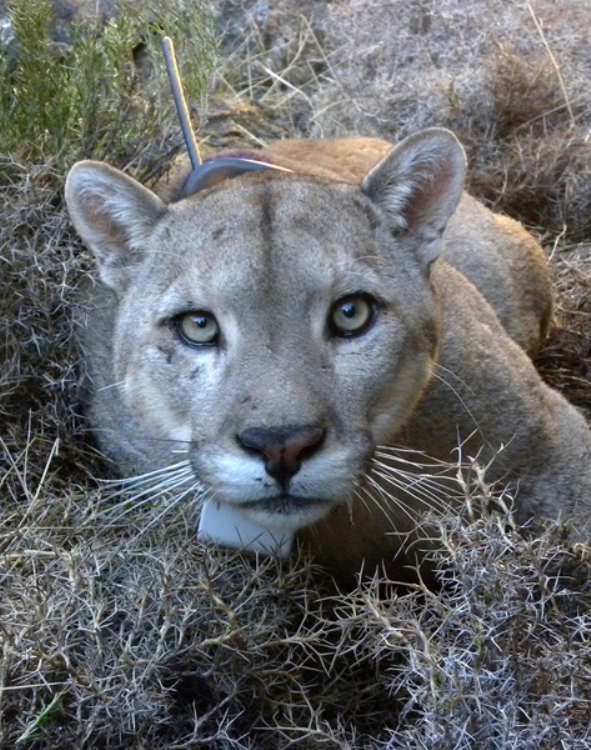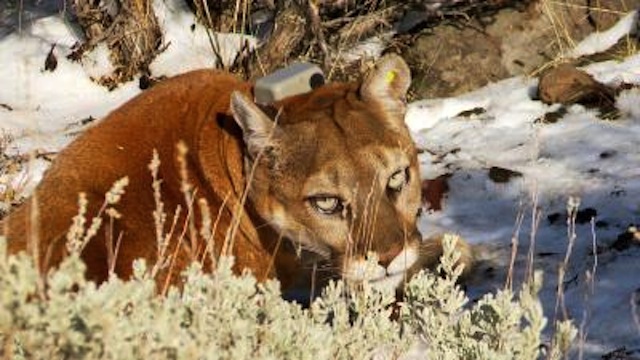Pumas, Panthers & Cougars: Facts About America's Big Cats

The puma is the big cat of the Americas. At one time, it ranged from the Yukon in Canada to the Strait of Magellan at the tip of South America. Because these cats were found in so many places, local tribes or explorers had their own name for the large felines, including cougar, mountain lion, Florida panther and catamount.
In fact, there are more than 80 names for the puma, more names than any other animal, according to the book "Cougar: The American Lion," by Kevin Hansen. It is important to note, though, that pumas are not bobcats, lynxes, jaguars, cheetahs or leopards.
Typically, pumas can be identified by a tan or slightly yellow coat, round face, long tail and erect ears. Adult males grow to 6 to 8 feet (1.8 to 2.4 meters) long and females average 5 to 7 feet (1.5 to 2.1 meters). Males typically weigh 110 to 180 lbs. (50 to 82 kilograms) and the female 80 to 130 lbs. (36 to 59 kg). A puma's tail is almost as long as its head and body combined.
Habitat & habits
Pumas can adapt to a wide variety of climates and habitats. They are found throughout Central and South America. In North America, however, hunting has reduced their range to isolated areas in Mexico, western U.S. wilderness areas, southern Florida and southwestern Canada, according to the Smithsonian National Zoological Park.
Unlike other cats, pumas do not live in packs. They live by themselves in large territories, which they mark using urine or feces. Pumas are solitary creatures for good reason. They need hunting room to find enough food to live. Only a few pumas can live in a 30-square-mile (78 square kilometers) radius.
Pumas are crepuscular creatures. They hunt during the twilight hours of dawn and dusk. The low light hides them from their prey. Their excellent night vision gives these predators a distinct advantage during these times of day.
Get the world’s most fascinating discoveries delivered straight to your inbox.
Diet
Pumas hunt using stealth and strength. To kill their prey — usually deer, elk or moose — the puma sneaks up behind the other animal and then chomps down on the prey's neck with its powerful jaws. To make the kill last longer, it hides its prey from other animals and eat bits of the carcass for several days. A puma typically kills a deer every 10 to 14 days, according to the Mountain Lion Foundation.
Pumas can drag prey several times their weight and, given the opportunity, will hunt domestic animals, such as sheep, pigs, horses and other livestock. They will also eat small animals such as porcupines, coyotes, rabbits, armadillos, capybaras, squirrels and raccoons. Some pumas hunt more than others. Patagonian pumas kill around 50 percent more prey than their North American counterparts, according to cougar biologist Mark Elbroch.
Offspring
After mating, the female will carry her young for a gestation period of 84 to 106 days, according to the University of Michigan Museum of Zoology. Then she will give birth to a litter of one to six cubs. These cubs are typically covered with spots that can help them blend in with their surroundings. A female will have a litter once every two years.
Classification/taxonomy
According to the Integrated Taxonomic Information System (ITIS), the taxonomy of pumas is:
- Kingdom: Animalia
- Phylum: Chordata
- Class: Mammalia
- Order: Carnivora
- Family: Felidae
- Genus: Puma (changed in 1993 from Felis)
- Species: Concolor
- Subspecies: Six subspecies are recognized: Puma concolor anthonyi, Puma concolor cabrerae, Puma concolor concolor, Puma concolor costaricensis (Costa Rican puma), Puma concolor couguar (Eastern puma) and Puma concolor puma.
Conservation status
Pumas once ranged from the Pacific to the Atlantic, but they were eliminated from eastern North America within 200 years of colonization, according to the International Union for Conservation of Nature. During the 20th century, large numbers of pumas were killed in the Midwest and Eastern United States by farmers and ranchers who didn't like the puma stealing their livestock. As a result, pumas almost became extinct in those areas.
The puma population is not increasing and more are being killed now than ever before because of habitat destruction, trophy hunting, poaching, poisoning and being struck by vehicles on roadways ("road kill"), according to the Mountain Lion Foundation.
Pumas are listed as "Least Concern" for extinction because they are so widespread, according to the IUCN. However, they are considered to be declining, and the Florida panther is considered endangered, and in Brazil, pumas are considered "Near Threatened."
The U.S. Fish and Wildlife Service lists the Florida panther, the Costa Rican puma and the Eastern puma as endangered.
Pumas are a protected species in many areas, with hunting prohibited in many South American nations. In the United States, hunting is legal in many Western states. California, however, banned hunting in a referendum in 1990. Hunting regulations are in place in Canada, Mexico and Peru.
Other facts
Pumas are extremely athletic. They can run up to 50 mph (80 kph) and jump as high as 15 feet (4.6 meters).
Pumas don’t roar. They use whistles, screams, squeaks and purrs to communicate. To signal to males that she's ready to mate, a female will rub against trees to leave her scent or will yowl loudly so that the local males can hear her call.
Though pumas are problems for ranchers or farmers, they have a very important role in the environment. They keep populations of animals lower down on the food chain in check. Without them, for example, those same farmers may have their crops overrun by hungry rabbits.
Other resources

 Live Science Plus
Live Science Plus






